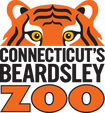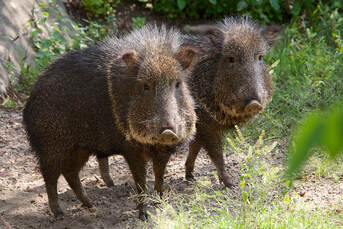Chacoan Peccary (Catagonus wagneri)
|
Physical Description: They are between 1.5 and 2.5 feet at the shoulder and weigh between 66-88 pounds. Their hair is course gray to gray-brown, interspersed with long guard hairs. Chacoan peccaries differ from the other peccary species by having longer ears, snout, and tail. There is a whitish collar across the shoulders and under the chin, which is thinner and less distinct than that in the collared peccary. The head is extremely large, and the nose tapers to a snout disk made of cartilage. They communicate by various sounds such as grunting and teeth chattering.
Peccaries are diurnal (active during the day) and tend to be most active in the early morning hours, then finding a mud wallow or dusty area to cool off as the day heats up. When frightened, Chacoan peccaries flee, raising the long hairs on their backs and spraying secretions from their dorsal glands. Scientists think that this is to keep the group together through dense brush by smelling the odor. These secretions are also rubbed against group members and are used as territorial markers. They are known as “spirit masters of the forest” by native people. Habitat: They inhabit Semi-arid thorn forests, savannah plains and seasonal marshes where temperatures are high and rainfall is low. This area has small trees, dense shrubs and various plants covering the ground, including cactus. Range: Chacoan peccaries live in one of the hottest and driest regions of South America, the Alto Chaco in Paraguay. Diet: Chacoan Peccaries feed on various species of cacti, fruit, roots herbs and occasionally invertebrates. They use their tough leathery snouts to roll the cacti on the ground, rubbing the spines off. They also pull the spines off with their teeth and spit them out. The kidneys of the Chacoan are specialized in breaking down acids from the cacti. Chacoan peccaries seek out salt licks formed from ant mounds to gain essential minerals. Lifespan: They live on average 9 years. Social Structure: Peccaries live in small groups of two to ten individuals, with most groups consisting of four to five adults and accompanying juveniles. These groups typically stay together even when they are being attacked. If running away proves impossible, as a defensive strategy, members of a herd may line up in a defense wall; this makes the herds easy targets for hunters. The breeding season for Chacoan peccaries is typically September through January but litters have been found almost year-round. Their litter size ranges from one to four young, with about a year between births. Status: Endangered1 Other: The populations are decreasing due to habitat clearance for cattle ranching, disturbance from development, isolation from other herds, commercial trade of their meat, and disease. 1 https://www.iucnredlist.org/species/4015/72587993 |








